A History of the County of Buckingham: Volume 2. Originally published by Victoria County History, London, 1908.
This free content was digitised by double rekeying. All rights reserved.
'Parishes: Ellesborough', in A History of the County of Buckingham: Volume 2, ed. William Page( London, 1908), British History Online https://prod.british-history.ac.uk/vch/bucks/vol2/pp331-338 [accessed 16 January 2025].
'Parishes: Ellesborough', in A History of the County of Buckingham: Volume 2. Edited by William Page( London, 1908), British History Online, accessed January 16, 2025, https://prod.british-history.ac.uk/vch/bucks/vol2/pp331-338.
"Parishes: Ellesborough". A History of the County of Buckingham: Volume 2. Ed. William Page(London, 1908), , British History Online. Web. 16 January 2025. https://prod.british-history.ac.uk/vch/bucks/vol2/pp331-338.
In this section
ELLESBOROUGH
Ellesborough is an irregularly-shaped parish, lying on the northern slope of the Chiltern Hills. It contains nearly 3,595 acres. (fn. 1) The highest point is Combe Hill, which is 852 ft. high, (fn. 2) but in the northern part of the parish the land lies between 300 ft. and 400 ft. above the Ordnance datum. In the hills the land is well-wooded, with 514¼ acres of woods or plantations. (fn. 3) The park at Chequers Court contains some fine timber. The subsoil is chalk and Upper Greensand, the surface variable—chalk and flint in the uplands and loam in the low-lying district. The occupation of the inhabitants is entirely agricultural; the proportion of arable land and permanent pasture is nearly equal, with 1,158 acres of arable and 1,143 of grass. (fn. 4) The main roads in the parish are the Upper and Lower Icknield Ways. The latter forms at this part of its course the main road from Wycombe to Aylesbury, and passes through Terrick End. The Upper Icknield Way wanders from the main road, running from Little Kimble Church to Wendover, through Ellesborough village and the hamlet of Butler's Cross. The parish is well watered by various streams running northwards; one of these turns the Ellesborough mill and another passes near Chalkshire. There are springs to the north of Ellesborough village, feeding a good-sized pond, used for water-cress growing. Moats still exist at Grove Farm, where there is an old dovecote, possibly of the 16th century, Terrick House, at which there are remains of 17th-century work much modernized, and Nash Lee Farm; there is a also reservoir near Beacon Hill in the southern part of the parish. Between Nash Lee and Terrick House the site of a Roman villa has been discovered, and various British coins (fn. 5) have been found in the parish. The nearest railway station is at Little Kimble on the Aylesbury branch of the Great Western Railway. Wendover station on the Metropolitan Extension Railway is 2 miles away. The parish was inclosed by an Act of Parliament (fn. 6) for the inclosure of the three parishes of Great and Little Kimble and Ellesborough, the award being dated 2 May 1805.
Manors
Before the Norman Conquest the township of ELLESBOROUGH was held in three parts, by Earl Harold, Baldwin the man of Archbishop Stigand, (fn. 7) and Levenot the man of King Edward. (fn. 8) The land held by Earl Harold (fn. 9) was assessed at 13½ hides, and was called a manor. At the Conquest it was given to Ralph Talgebosch or Taillebois, but before the Domesday Survey was made he had exchanged it with Ansculf de Picquigny for half of Risborough at the king's command, and William Fitz Ansculf was the tenant in 1086. (fn. 10) The latter also held the land of Baldwin, but had enfeoffed Osbert as his sub-tenant. (fn. 11) Ralph Paganell became possessed of all the lands of Fitz Ansculf, (fn. 12) which formed the honour of Dudley or Newport. He was succeeded by his son Gervase Paganell, (fn. 13) who paid feudal dues for lands in Buckinghamshire in 1190–1. (fn. 14) Four years later, however, his honour (fn. 15) was in the hands of the king, but it afterwards passed to Ralph de Someri, (fn. 16) the son of John de Someri, who had married Hawisia Paganell. (fn. 17) The Someris held the honour until the death of John de Someri in 1323, (fn. 18) when his possessions were divided between his two sisters Margaret and Joan, and Ellesborough was assigned to the latter, (fn. 19) who was the widow of Thomas Botecourt. The overlordship appears to have lapsed after the honour was broken up, and in the 15th century this part of Ellesborough was held in chief under the honour or castle of Nottingham. (fn. 20)
In 1086 (fn. 21) Ralph held the manor of ELLESBOROUGH of William Fitz Ansculf, but its descent in the following century is lost. At the close of the 12th century, however, it was in the hands of Richard son of William, but he, during the civil wars of the reign of John, granted it to William Cauntlow. (fn. 22) A dispute arose between his widow Geva and William Cauntlow in 1224 (fn. 23) about her dower. An agreement had previously been made between them, (fn. 24) but in spite of this she brought a claim for a third part of the manor, which she obtained by judgement of the king's court. William Cauntlow died in 1239 (fn. 25) and was succeeded by another William Cauntlow, (fn. 26) who held the manor as mesne lord till his death in 1251. (fn. 27) He had been the close friend of Henry III, (fn. 28) but this friendship was not extended to his son and heir William, (fn. 29) whom the king treated with great harshness. (fn. 30) He did homage for his lands in the same year, 1251, but only survived his father a short time. His early death, which took place in 1254, (fn. 31) was lamented by the chronicler Matthew Paris, (fn. 32) by whom he was described as 'juvenis elegans et dives.' His heir was his son George, who was either two or three years old at the time of his father's death. (fn. 33) George died just after reaching his majority, (fn. 34) and Ellesborough passed to Milicent, the elder (fn. 35) of his two sisters and coheiresses. She had married first Eudo la Zouche, (fn. 36) and afterwards John de Montalt. (fn. 37) Ellesborough passed to her son William la Zouche, (fn. 38) and on his death in 1352 (fn. 39) he was succeeded by his grandson William la Zouche of Harringworth, (fn. 40) who afterwards gave the manor of Ellesborough to his second son Thomas to hold in demesne for life. (fn. 41) The latter died seised in 1404, and the manor reverted to his nephew William la Zouche, (fn. 42) the son of his elder brother William. The reversion, however, had already been granted by William la Zouche to Henry, Bishop of Lincoln, and other feoffees in 1402, (fn. 43) and William la Zouche made a further release of his right in the manor of Ellesborough to John Toly and William Glen, clerks, (fn. 44) two of the original feoffees. At his death, however, in 1416, he was said to have enfeoffed Sir William de Roos of Hamelake (fn. 45) and others, probably another set of trustees, of the manor; but only Thomas, Lord Berkeley, Thomas le Warr, and Robert Isham survived at that date. (fn. 46) William la Zouche left a son William, in whose interest the feoffments had probably been made. In 1430 (fn. 47) the manor appears to have been held by Thomas Bronus, clerk, Roger Heron, clerk, Robert Chatheley, John Barton the younger, and Thomas Compworth, but they then conveyed it to John Cotesmore, John Cheyne, and others. (fn. 48) Henry Chicheley, Archbishop of Canterbury, (fn. 49) also released his right in the manor to the new feoffees. These numerous enfeoffments seem to cover a transfer of the manor between 1416 and 1430 from the Zouche family to John Cheyne, who held it in 1432. (fn. 50) Shortly afterwards, however, Cheyne enfeoffed Thomas Frowyk, (fn. 51) Henry Frowyk, and William Walton, (fn. 52) who held the court of the manor in 1442. (fn. 53) Cheyne and his feoffees next released the manor to John Hampden of Kimble (fn. 54) and Edward Brudenell on condition that they enfeoffed John Brekenok (fn. 55) on his payment of a sum of money to Cheyne. Brekenok failed to pay at the appointed date, (fn. 56) and Cheyne tried to recover the manor from Hampden and Brudenell, who refused to relinquish it. (fn. 57) Brekenok probably paid after a time and held the manor till 1458, when he and his wife quitclaimed it to John Heton, Edward Brudenell and others for £200. (fn. 58) Who was in actual seisin at this time is very doubtful, but the manor shortly afterwards must have passed to the Poles, since in 1479 Geoffrey Pole died seised. (fn. 59) His son Richard, who married Margaret daughter of the Duke of Clarence, inherited it. (fn. 60) Their son Henry Pole, Lord Montagu, a minor at his father's death, (fn. 61) had livery of his lands in 1513, (fn. 62) but afterwards was attainted and executed, and his possessions reverted to the Crown in 1539–40. (fn. 63) Henry VIII sold the manor of Ellesborough to Sir John Baldwin, Lord Chief Justice of Common Pleas, (fn. 64) for £623 18s. 5½d. (fn. 65) From him it descended to one of his two grandsons and heirs, Thomas Pakington, the son of Ann Baldwin and Robert Pakington. (fn. 66) It was held by the Pakingtons, his descendants, (fn. 67) until it was bought in 1770 by Sir John Russell, who held the manor of Chequers in Ellesborough. (fn. 68) The Pakingtons claimed the paramount lordship in Ellesborough in the 18th century, (fn. 69) but this claim was abandoned when a farm in the parish was bought of the Pakingtons by the Russell family. The manor of Ellesborough is now held by the trustees of Mr. Frankland-Russell-Astley, who has inherited the estates of the Russells. (fn. 70)

Cauntlow. Gules three fleurs-delis coming out of leopards' heads reversed or.

Zouche. Gules bezanty and a quarter ermine.
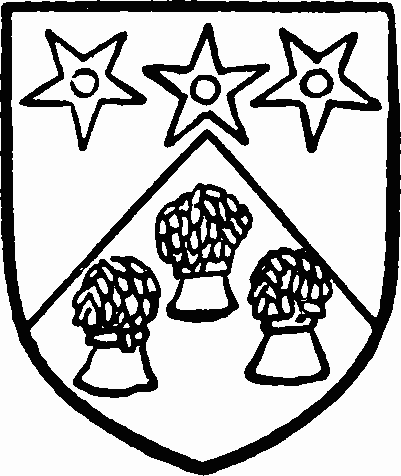
Parkington. Party cheveronwise sable and argent with three pierced molets or in the chief and three sheaves gules in the foot.
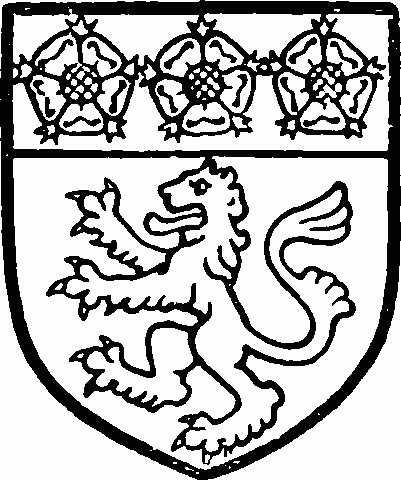
Russell. Argent a lion gules and a chief sable with three roses argent therein.
In the 13th century the manor of Ellesborough was held for a time by a younger branch of the Cauntlows. The first William Cauntlow or his son and heir, William, apparently subinfeudated Nicholas the second son, (fn. 71) who was seised in 1254. (fn. 72) William, the son of Nicholas, succeeded him, but granted the manor to his mother Eustachia and William de Ros her second husband for life. (fn. 73) He, however, was re-enfeoffed jointly with his wife Eva for their lives by Eustachia and her husband, (fn. 74) and held the manor at his death in 1308. (fn. 75) It then reverted to his mother and William de Ros for life. William Cauntlow's heir (fn. 76) was his son another William, but the latter died childless, so that Nicholas his brother obtained the manor on its reversion to the Cauntlows. (fn. 77) Nicholas settled the manor of Ellesborough on his wife Joan for life, (fn. 78) with remainder to Nicholas his grandson and son of William Cauntlow and the heirs of his body. (fn. 79) If these failed the further remainder was granted to William brother of Nicholas with the same restrictions. (fn. 80) Nicholas the grandson died without heirs of his body, (fn. 81) and William obtained seisin of the manor. (fn. 82) He died in 1376, his father William Cauntlow being his heir. (fn. 83) The latter seems to have had no other children besides the two sons who had predeceased him, so that on his death the manor reverted to the Zouches, as the representatives of the elder branch of the Cauntlow family. (fn. 84)
William Cauntlow held the view of frankpledge for his moiety of the parish of Ellesborough, (fn. 85) but in 1254 the origin of his right to do so was unknown. (fn. 86) Probably, however, Richard son of William who had granted his father the manor of Ellesborough had also held the view, and Cauntlow continued to do so without any definite grant. The view was probably held by the Zouches, and in the 15th century the feoffees of Sir John Cheyne held it, (fn. 87) the right afterwards coming to the Pakingtons in the 17th century. (fn. 88) In the reign of James I (fn. 89) Edward Brudenell obtained a grant of a court leet and view of all his tenants in Stoke Mandeville, Ellesborough, and Little Kimble, to be held twice a year, but probably the Ellesborough tenants belonged to his manor of Stoke Mandeville.
APPESLEY alias APSLEY is first mentioned in a charter of Roger de Hampton, granting 5s. rent to the abbey of Missenden, which William de la Merse paid him for land in 'Aspeleia.' (fn. 90) It presumably belonged to the honour of Dudley, since in 1486–7 it was held of Geoffrey Pole, who then held the manor of Ellesborough. (fn. 91)
In 1247 (fn. 92) William de Appesley brought an action against the Abbot of Missenden concerning a free tenement and rent in Ellesborough.
Another William de Appesley was plaintiff in a fine for lands and rents in Ellesborough in 1316, (fn. 93) but the manor of Appesley is not definitely mentioned until 1486–7, on the death of Thomas Temple. (fn. 94) His heir was his son William, a minor. During the reign of Henry VIII Francis Temple obtained possession of the manor probably in succession to William. He was seised in 1537, (fn. 95) and made various settlements for the use of himself and his wife Elizabeth and the heirs of their bodies. After his death (fn. 96) Elizabeth brought several actions against lessees of the manor and lands to recover possession. (fn. 97) It seems to have passed to one John Temple by 1575, (fn. 98) and from him to Thomas Temple before 1584–5, (fn. 99) since in that year Thomas, together with his wife Cecily, sold Appesley Manor to William Sheppard of Great Rollright, co. Oxon. (fn. 100) It passed on his death in 1625 (fn. 101) to his son William, whose descendants held the estate (fn. 102) until 1733, (fn. 103) when William Sheppard sold it to William Ledwell. His son William Bridges Ledwell again sold the manor of Appesley in 1792 (fn. 104) to Sir Scrope Bernard, afterwards Sir Scrope Bernard Morland, bart. At the beginning of the 19th century it had again been sold to James Humphreys, (fn. 105) but it 1844 it was obtained by Mr. Edward W. Blanchard. In 1894 Lieut.-Colonel Horwood of Walton Warren, Aylesbury, purchased Appesley Manor Farm, and is the owner at the present day. (fn. 106)
The reputed manor of MORDAUNTS in the parish of Ellesborough was held as a sub-manor under the Cauntlows, and so belonged to the honour of Dudley. In 1274–5 Lawrence de Brok died seised of 6 marks rent, which he held of Nicholas Cauntlow. (fn. 107) His son and heir was Hugh de Brok, (fn. 108) who held the same rent in 1284–6. (fn. 109) Hugh died before 1300, when his widow Isabel granted away certain lands and rents in Ellesborough for the term of her life. (fn. 110) Another Lawrence de Brok, her son, held tenements in Ellesborough, (fn. 111) the rents and services from which he granted to John de Bykton for fourteen years, and in 1309 made a settlement of 100s. rent in Ellesborough on himself and his wife Ellen. (fn. 112) His lands descended to his granddaughter Helen, (fn. 113) who married Edmund Mordaunt. (fn. 114) The latter died seised of rents in Ellesborough in 1374, (fn. 115) which were held of William Cauntlow; he was succeeded by his heir Robert, then a minor. The Mordaunts presumably held this rent in Ellesborough uninterruptedly during the 15th century, and in 1504 or 1505 Sir John Mordaunt held land in Ellesborough. (fn. 116) He was raised to the peerage as Baron Mordaunt of Turvey, and was succeeded by his son and grandson in turn. (fn. 117) In 1560 (fn. 118) their possessions in Ellesborough were described as the manor of Ellesborough, and this name was again used when Lewis the third Lord Mordaunt sold it to William Hawtrey in 1571. (fn. 119) It afterwards became known as the manor of Mordaunts, and from the time that it passed to the Hawtreys was held with the manor of Chequers (q.v.). (fn. 120)
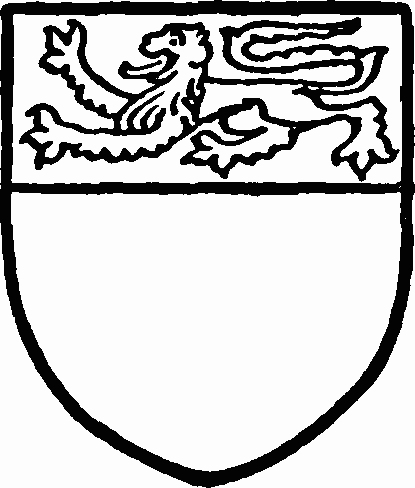
Brok. Gules a chief argent with a lion passant gules therein.
The first Laurence de Brok held his rent from Nicholas Cauntlow by the service of a clove gillyflower paid annually, (fn. 121) but in 1374 Edward Mordaunt held it by military service. (fn. 122)
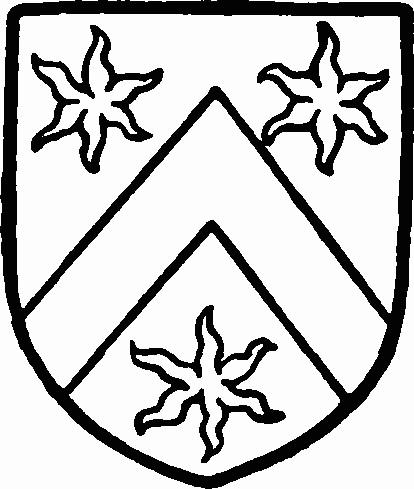
Mordaunt. Argent a cheveron between three stars sable.
William Fitz Ansculf subinfeudated the 1½ hides of land in Ellesborough that Baldwin had held before the Norman Conquest. (fn. 123) They were held at the time of the Domesday Survey by Osbert, who also held the manor of Great Hampden. (fn. 124) This land probably came into the possession of the Hampdens, (fn. 125) the successors and possibly the descendants of Osbert. In 1200 (fn. 126) —de Hinton paid 1 mark to the king for a judgement as to half a knight's fee in 'Esseburg,' which was apparently given in his favour against Michael Malherbe and his wife Mabel. Twenty-one years (fn. 127) afterwards Robert de Pinkeny paid 1 mark for a similar suit as to 11 virgates of land against Roger de Hampton and his wife Mabel. Roger held land in Ellesborough in 1240–1, (fn. 128) but he had died before 1247, in which year his widow claimed land there as her right. (fn. 129) Whether this Roger was any relation to the main branch of the Hampden family does not appear. He had granted certain land to the first William Cauntlow in 1228, (fn. 130) and it seems possible that all the land belonging to the honour of Dudley became united under the Cauntlows.
The third part of the township was given after the Conquest to Maigno the Breton, (fn. 131) and was held by his descendants as half a knight's fee belonging to their barony of Wolverton. It passed to his descendant Hamo son of Meinfelin who, in 1166, owed the service of fifteen knights to the king. (fn. 132) Hamo was succeeded by his son, known as Hamo son of Hamo, (fn. 133) and the latter confirmed a grant of land in Ellesborough made to Missenden Abbey. (fn. 134) On his death his son William obtained his possessions, (fn. 135) but taking part with the barons against King John he forfeited them for a time. (fn. 136) He made his peace in 1216, paying a fine to the king, (fn. 137) and held the barony of Wolverton till his death c. 1248. (fn. 138) In that year his brother and heir Alan son of Hamo did homage to the king for his lands, (fn. 139) but in the same year the new lord of Wolverton died and was succeeded by his son John son of Alan. (fn. 140) John was the overlord of this part of Ellesborough in 1254, (fn. 141) and presumably held it till his death in 1271–2. (fn. 142) It was amongst the knights' fees assigned on dower to his widow Isabella, who married as her second husband Ralph de Ardena. (fn. 143) John son of Alan's heir at the time of his death (fn. 144) was his son Richard a boy five years old, but he seems to have died before he came of age and the barony of Wolverton passed to his brother John. (fn. 145) The family at this time appear to have taken the surname of Wolverton. (fn. 146) This John was a knight in 1318 (fn. 147) and died before 1342. (fn. 148) He was succeeded by his son John de Wolverton (fn. 149) and grandson Ralph de Wolverton. (fn. 150) The latter, however, died while still a minor, and the barony was divided between his two sisters Margaret and Elizabeth. (fn. 151) The former was betrothed at the time of her brother's death to John le Hunte, and the overlordship of Ellesborough was assigned to her. (fn. 152) Her daughter and heiress Joan succeeded her and married John Longville. (fn. 153) inheritance by courtesy after her death for his life, (fn. 154) and then it passed to her son and heir George Longville. (fn. 155) His descendants held her moiety of the honour of Wolverton until the 17th century, and in 1636 Sir Henry Longville held the overlordship of half a knight's fee in Ellesborough among his other possessions belonging to the manor of Wolverton. (fn. 156)
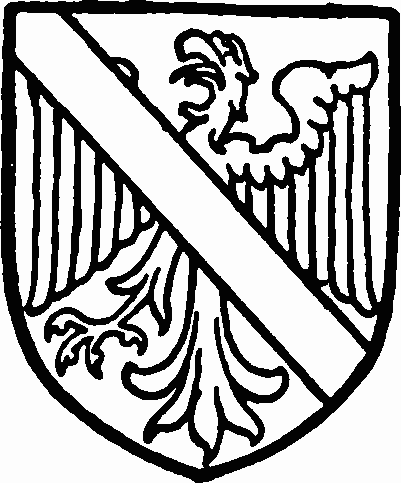
Wolverton. Azure an eagle or with a bend gules over all.
In 1254 John son of Alan paid 3s. a year to be quit of suit to the shire and hundred courts and 2s. for the right to hold the view of frankpledge for his tenants at Ellesborough. (fn. 157) No further mention of this view is made, but probably the lords of the barony of Wolverton held a view for all the tenants of their barony.
The land held under the honour of Wolverton was probably subinfeudated before 1166 and one moiety of it was afterwards known as SEYTON'S MANOR or the MANOR OF GROVE. William Brito held certain land in Ellesborough (fn. 158) shortly after that date, and may perhaps be identified with William son of Alan who was then one of the knights of Hamo son of Meinfelin. (fn. 159) William Brito granted land to Missenden Abbey in the time of Hamo son of Hamo. (fn. 160) He seems to have been succeeded by Alan Brito, possibly his son, who died during the reign of Richard I. (fn. 161) A lawsuit was held as to his lands in Ellesborough between his nephew Simon de Maidwell, apparently his heir, and William de Med menham, who called to warranty his wife Matilda, who in her turn called to warranty Henry de Pinkeny; the last-named had, it was alleged, given the land to Matilda'a father. The result of the suit is not given, but Simon de Maidwell was one of the parties to various fines concerning land in Ellesborough at the time, the last being in 1202. (fn. 162) He also obtained a grant of free warren in his lands there from Henry III. (fn. 163) He was succeeded by Alan de Maidwell, probably his son, (fn. 164) who was defendant in a suit as to land in Ellesborough, and about that time held a quarter of a knight's fee of the barony of Wolverton. (fn. 165) He is mentioned for the last time in 1241. (fn. 166) Possibly he left a son Simon, since in 1261 or 1262 Alice daughter of Simon de Maidwell recovered various charters of lands in Ellesborough, which had been kept by the executor of her father's will. (fn. 167) She was a minor in the wardship of Richard de Seyton of Maidwell, Northamptonshire. (fn. 168) He married his ward, and her land, which she held as the heiress of William Brito, passed to the Seyton family. (fn. 169) She died before 1284–6 and was succeeded by her son John de Seyton. (fn. 170) He was at that time a minor, and his land was in the wardship of Anthony de Bek. (fn. 171) He was holding it himself in 1302, (fn. 172) but had been succeeded before 1312 by Nicholas de Seyton. (fn. 173) Nicholas died in or just before 1316, (fn. 174) and his manor passed to his son John de Seyton, who held it till his death. (fn. 175) His son and heir John de Seyton did homage for his manors to his overlord in 1361–2. (fn. 176) John made two grants of the manor of Grove to feoffees, who were presumably trustees for his lands while he went to the Holy Land. (fn. 177) He died at Jerusalem in 1396 (fn. 178) and was succeeded by his son and heir John. The latter held the manor till his death, which took place about 1436–7. His son Thomas de Seyton assigned it at that date in dower to his father's widow Joan, (fn. 179) but in 1446 he granted the manor of Grove to John Kempe, Cardinal and Archbishop of York, John Stopyngton, Thomas Kempe, and others. (fn. 180) These grantees in 1459 (fn. 181) conveyed the manor to Sir Ralph Verney and Robert Whittyngham and others, to the use of Ralph Verney his heirs and assigns. The Verneys held the manor for about a hundred years, (fn. 182) John Verney being seised of the manor in 1530, (fn. 183) and Edmund Verney in 1553. (fn. 184) It changed hands shortly afterwards and passed to Robert Hewster of Chalford, Oxfordshire, who in 1564 conveyed it to Nicholas Eggleton. In 1579 the latter complained that his son and heir William had entered into the manor and detained certain deeds concerning it, but by 1596 Nicholas had recovered seisin. (fn. 185) In 1631 (fn. 186) Christopher Eggleton was lord of the manor, and in that year settled it on his son Christopher on the marriage of the latter with Margaret daughter of Thomas Style. (fn. 187) They were in seisin in 1654, (fn. 188) and were succeeded by Thomas Eggleton, whose daughter and heiress Amy married Sir Lyon Pilkington, bart. (fn. 189) The latter was seised together with his wife in 1694, (fn. 190) but they shortly afterwards, or possibly at that date, sold the manor of Grove. Presumably it passed into the hands of Alexander Horton 'of the Grove' who died in 1715–16. (fn. 191) William Horton shortly afterwards held the manor, (fn. 192) but in 1735 he sold it to John Bristowe. (fn. 193) Richard Bristowe held it in 1768, but he or his heir sold it in 1798 to Sir John Russell, and from that time it has followed the descent of the manor of Chequers (q.v.). (fn. 194)
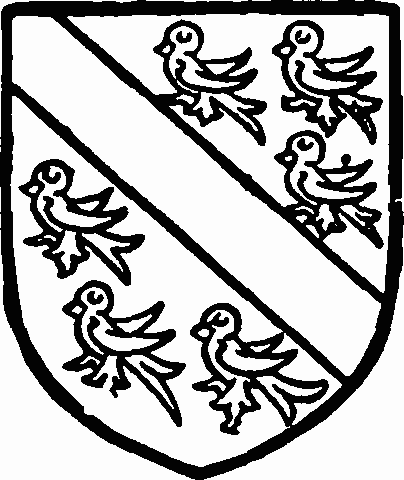
Seyton. Gules a bend between six martlets argent.
The manor of CHEQUERS belonged to the halffee in Ellesborough held under the barony of Wolverton, but it is difficult to ascertain whether it was held immediately from the lords of Wolverton or from the de Maidwells and Seytons as mesne lords. (fn. 195) The name of Chequers was probably derived from the name of the first tenants. Helyas de Scaccario, or of the Exchequer, appears amongst the witnesses to two charters, (fn. 196) one of which is dated 1187, to the abbey of Missenden. Henry de Scaccario was the plaintiff in several lawsuits in the beginning of the 13th century, (fn. 197) and held a quarter of a knight's fee in Ellesborough of the barony of Wolverton. (fn. 198)
Henry de Scaccario had a son Ralph, whose daughter and co-heiress Catherine married William Hawtrey. (fn. 199) In 1286 lands in Ellesborough were conveyed by William Hawtrey, jun., to William Hawtrey, sen., and Katharine his wife. (fn. 200) In 1383 William Hawtrey, and in 1422 Richard Hawtrey, both appear in charters referring to the manor of Grove. (fn. 201) In 1350 (fn. 202) and 1439 (fn. 203) the heir of Henry de Scaccario held a quarter of a knight's fee of the barony of Wolverton, and as late as 1544 Thomas Hawtrey died seised of the manor of Chequers, with land and tenements in Ellesborough. (fn. 204) His heir was William his grandson, (fn. 205) son of Thomas Hawtrey and Sibilla daughter and co-heiress of Richard Hampden of Kimble. (fn. 206) The son of William Hawtrey died leaving four daughters, of whom the eldest, Mary, married Sir Francis Wolley. (fn. 207) She probably inherited the manor of Chequers, since a settlement of the manor was made in 1594 (fn. 208) by William Hawtrey and Sir John Wolley. Mary died without children, (fn. 209) and the manor passed to her next sister Bridget, the wife of Sir Henry Croke. (fn. 210) His son Sir Robert Croke was certified as a delinquent during the Commonwealth, but he was said to have had no real property in Ellesborough. (fn. 211) In 1660, however, he was seised of the manor of Chequers, (fn. 212) and on his death in 1680 the manor passed to his daughters. Susan, the eldest, had married Samuel Wall, M.D., (fn. 213) but neither she nor the third sister Isabella had children, and Mary the second sister obtained the whole estate of Chequers. (fn. 214) She married John Thurban, serjeant-at-law, and the manor descended to their daughter Johanna, (fn. 215) who married first Colonel John Rivett. Her three sons, of whom the eldest, John Rivett, was a party to a common recovery in 1759, (fn. 216) all died leaving no children, and the manor passed to their sister Mary Johanna, the wife of Colonel Charles Russell. (fn. 217) Their son Sir John Russell, bart., was seised of the manor in 1765. (fn. 218) He died in 1783, (fn. 219) and was succeeded by his two sons John and George in turn, but both died without direct heirs. On the death in 1804 of Sir George Russell, who had enlarged the estates of his family in the parish of Ellesborough by various purchases, (fn. 220) Chequers passed under the will of his father to his aunt, Mary Russell, with remainder to the Rev. John Russell Greenhill. (fn. 221) The latter was a descendant of Elizabeth, the sister of Colonel Charles Russell. (fn. 222) The estate, however, was given up by them to Robert Greenhill, the son of John Russell Greenhill, who held it in 1813. (fn. 223) He took the name of Russell in addition to Greenhill, and was created a baronet in 1831. (fn. 224) On his death in 1837 Chequers passed to Sir Robert Frankland, bart., (fn. 225) a distant kinsman of the Russells. He assumed the name of Russell, by sign manual, and on his death in 1849 left five daughters as his heiresses. (fn. 226) Chequers came to the youngest, Rosalind, the wife of Colonel Astley, (fn. 227) and she took the additional names of Frankland-Russell in 1872. On her death in 1900 she was succeeded by her son Bertrand Frankland-RussellAstley, who was lord of the manor till his death in 1904. Chequers is now in the hands of the trustees of his son Henry Frankland-Russell-Astley, a minor.
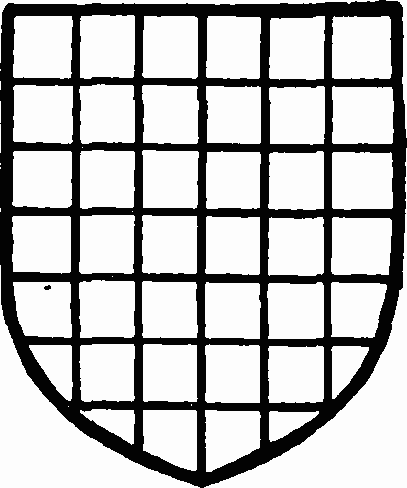
De Scaccario. Checky argent and azure.
Chequers Court is situated in a small valley in a position south-south-east of the parish church. The many small hills by which it is surrounded and the slopes and spurs of the Chilterns forming the park are thickly wooded with beech trees, interspersed with larch, holly, and box.
The present house dates from the end of the 15th century, but is on the site of an earlier building of which no traces remain. The 15th-century house appears to have consisted of a central block with two projecting wings, the fourth side of the court being probably formed by a wall. In 1565 the house was much altered by Sir William Hawtrey, but the present north and east fronts are apparently a part of the earlier work, though re-decorated.
The west wing was completely rebuilt by Sir George Russell towards the end of the 18th century, and the south front was at the same time much altered, while both fronts were stuccoed and gothicized in the approved manner of that date. A small wing with a clock tower was added, a little later, at the southwest. Considerable alterations were made during the 19th century, and a good deal of oak panelling is said to have been cleared out. In more recent years, however, the house has been restored to something approaching its original form. The gables which had been battlemented have been restored and the stucco almost completely cleared off. Mullioned windows have also been inserted in place of some of the 18thcentury sashes and the court has been covered in to form a hall.
The library is a large gallery occupying the greater part of the west wing, and though altered in the 18th century retains its mullioned windows. Over the bay window appear the Croke arms. Over the drawing-room bay, a part of the 16th-century work, appear the Hawtrey arms and the initials A.H. and W.H., with the date 1565. The house contains many pictures of great interest and a large collection of Cromwellian relics, including some of the Protector's clothes, his sword, jack boots, &c., and several contemporary portraits.
Church
The church of St. PETER AND ST. PAUL (fn. 228) consists of a chancel 30 ft. by 18 ft. with south organ chamber and vestry; a nave 52 ft. by 21 ft. 2 in. with south aisle 9 ft. wide, south porch, and a south-west tower 10 ft. 6 in. square, all measurements being internal.
The whole building seems to be of 15th-century date, with modern additions and repairs, and has had its outer surface entirely renewed, so that hardly a trace of old work shows on the outside.
The situation is an unusually fine one at the top of a spur of the Chiltern Hills, 500 ft. above the Ordnance datum and overlooking the Vale of Aylesbury.
The east window of the chancel is completely modern and of three cinquefoiled lights with tracery over. The two windows in the north wall of the chancel are also modern and of late 14th-century detail, that to the east being of two lights, and that to the west of three, while in the south wall is a two-light window like that opposite to it on the north and the door and arch to the vestry and organ chamber, all modern and of plain detail. In this wall is a small 15th-century piscina with a shelf and a bracket, the head of its recess being embattled. The chancel arch is also much restored, but in the main of 15th-century date.
The nave is of five bays and is lit on the north by three large three-light windows with modern tracery of 15th-century detail in 15th-century openings. The blocked north door is between the west pair of windows and is of two moulded orders contemporary with the rest; it has a trefoiled recess for holy water to the east. The south arcade is of four bays with four-centred arches of two moulded orders, octagonal pillars and capitals, the abaci of the capitals being slightly concave in plan.
West of the arcade is a single arch to the tower which is built at the west end of the aisle. The arch detail is identical with that in the nave arcade, while the abacus of the west respond of the arcade is continued round the north-east pier of the tower and runs into the capitals of the tower arches. The west window of the nave is of three lights like those on the north and, like them, has modern tracery in a 15th-century opening. The west door externally is completely modern but the internal reveal and moulded rear-arch are of 15th-century date.
At the east end of the south wall of the aisle is a two-light window similar in detail, date, and degree of restoration to the north windows of the nave, but somewhat broader in proportion. The south door opposite the fourth bay of the arcade is continuously moulded with a double ogee and, externally at least, is quite modern. West of this is a modern single cinquefoiled light with tracery over.
The south porch is completely modern and has a continuously moulded entrance arch of 14th-century detail, over which are a pair of modern niches containing figures of St. Peter and St. Paul.
The south-west tower is of three stages with an embattled parapet and a south-east octagonal turret staircase, it is of considerable height with belfry windows of two cinquefoiled lights, single trefoiled lights in the second stage, and a two-light west window on the ground stage.
The font has an octagonal 14th-century bowl upon a modern base and stem. The bowl is moulded and of ogee profile, its faces being panelled with flowing tracery in relief. The roofs throughout are modern.
In a recess in the aisle is a handsome black and white marble monument to Bridget Croke, 1638. On a moulded sarcophagus of black marble is the white marble effigy of a woman in the costume of the period of Charles I, an extremely well executed and well preserved piece of work, the various details of the costume being treated with the utmost care and exactness. Above the effigy is a white marble semicircular pediment springing from the cornice of a complete entablature of the composite order, which is supported on either hand by a free and an engaged black marble column with white marble bases and capitals. The soffit of the entablature is panelled, the panels having alternately cherubs' heads and rosettes in relief. The inscription is cut on a slate slab let into the white marble back and has no date. Above is Croke impaling Hawtrey, between Croke and a lozenge with Hawtrey.
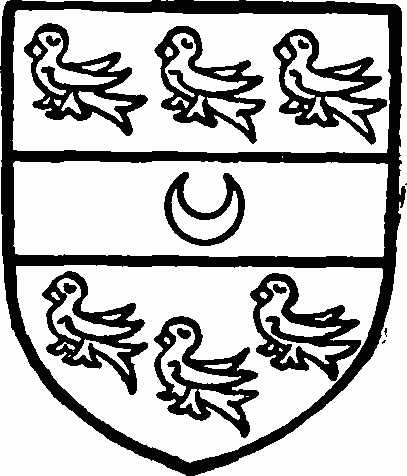
Croke. Gules a fesse between six martlets argent with a crescent sable on the fesse for difference.
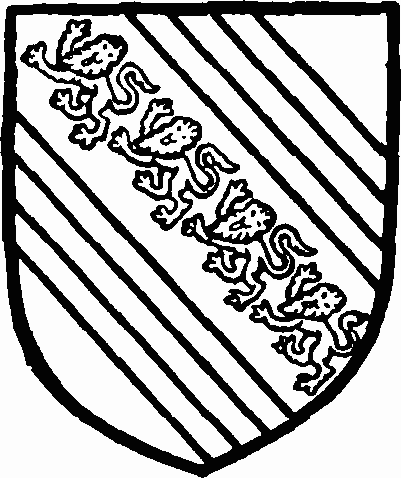
Hawtrey. Argent four leopards passant bendways between double cotises sable.
In the north aisle on the wall is a brass with the figures of Thomas Hawtrey, 1544, Sybil his wife, and eleven sons and seven daughters, with the Hawtrey shield, apparently engraved over another coat. Below is the inscription of another brass to Mary, 'somtyme the wyfe of Will[ia]m Hawtrey,' who died in 1555. In the floor of this aisle are slabs to the following: Henry Croke, 1588, with the Croke arms quartering a fesse nebuly between three rings; Henry Croke, 1662, with Croke quartering a shield bearing a chaplet; Sir Robert Croke, 1680, with Croke bearing the last quartered shield in pretence, and Susannah Croke, 1685. In the chancel is also a slab to Robert Wallis rector, 1666. In the windows of the organ chamber are preserved a few fragments of 15th and 17th-century glass. There is no woodwork of any interest in the church, but in the vestry is a large chest with handsome brass hinges, lock-plate, &c. of 17th-century date.
The tower contains six bells, the treble cast by Mears and Stainbank in 1870; the second, third, fourth, and tenor by Thomas Mears, 1823, and the fifth by G. Mears, 1863.
The church plate consists of a large covered cup of 1569, of extremely graceful design with a band of typical Elizabethan ornament. The sacred monogram and some of the Crucifixion emblems have been engraved on it at a later date; there are also a plated flagon and salver.
The first book of the registers contains all entries between 1603 and 1663. The second book (overlapping the first) contains baptisms from 1659 to 1739; burials from 1660 to 1739, with burials in woollen from 1678 and marriages from 1662 to 1739. A third book contains all entries from 1740, baptisms and burials running to 1812, and marriages to 1753. A fourth book contains the marriages and banns from 1754 to 1812.
Advowson
Towards the close of the reign of Henry II Gervase Paganell, then lord of Dudley honour, granted to the priory of Sandwell, in Staffordshire, as much of the church of Ellesborough as appertained to his honour. (fn. 229) In 1398 the prior and convent obtained leave to impropriate their half of the church, (fn. 230) and on the death or resignation of the rector then holding the benefice, to serve it by a secular priest or by one of the monks of Sandwell. In the 15th century a lease of the advowson and half the rectory (fn. 231) was held under the priory by Henry Danvers, William Danvers, and Joan Selwood in turn. (fn. 232) In 1524, however, the house was dissolved, and no vicarage is mentioned amongst its possessions, (fn. 233) but only the advowson of the rectory of Ellesborough and tenements there, and in 1535 the benefice is described as a rectory. (fn. 234) The priory of Sandwell was amongst the religious houses dissolved and granted to Cardinal Wolsey for the endowment of his new college at Oxford, (fn. 235) and the advowson and half the rectory of Ellesborough were in consequence given to Cardinal College. (fn. 236) When Wolsey fell from the king's favour his foundation was deprived of many of its possessions; those in Ellesborough passed by an exchange, made in 1531 by Henry VIII, to the Carthusian Priory of Sheen. (fn. 237) After the dissolution of Sheen in 1539, (fn. 238) the advowson of the church of Ellesborough was granted to William Sewster, who, however, very shortly obtained leave to alienate it to William Gardiner and his wife Anne. (fn. 239) Gardiner died seised of the advowson in 1558, (fn. 240) but his son and heir John Gardiner sold it to Roland Beresford. (fn. 241) The advowson changed hands from this time with great rapidity, passing from Beresford to Henry Newman in 1599–1600, (fn. 242) and from Newman to Thomas Weedon in 1620. (fn. 243) Weedon held it at his death in 1624, (fn. 244) but his brother and heir William sold it to Robert Wallis, clerk, ten years later. (fn. 245) His family still held the advowson in 1725, (fn. 246) but before 1728 it had passed into the possession of Joseph Wells of Aston Clinton. (fn. 247) He died in 1732, and the advowson passed to his son the Rev. Joseph Wells, who was still the patron of the living in 1813. (fn. 248) In the previous year he had sold the advowson to Sir Robert Greenhill Russell, presumably reserving to himself the next presentation. (fn. 249) It is now in the hands of the FranklandRussell-Astleys. The moiety of the rectory granted to the prior of Sandwell by Gervase Paganell was held with the advowson until the sale of the latter to Sir Robert Greenhill Russell; Joseph Wells appears to have retained the rectorial estate in his own hands. Allotments were made under the Inclosure Act of 1803 for the glebe rights of common and the great and small tithes. On the death of the Rev. Joseph Wells in 1818, the allotment passed to his widow, with remainder to her son Fleetwood Wells. The lords of the honour of Wolverton probably granted their half of the church of Ellesborough to their subtenants, with the manor of Grove. William Brito presented to the church in the reign of Henry II, (fn. 250) and his heirs Richard de Seyton and his wife Alice claimed the advowson in 1276 against the Prior of Sandwell. (fn. 251) The plaintiffs lost their case, not, however, because they had no right to the advowson, but because their moiety of the church was not vacant at the time. When Thomas de Seyton granted the manor of Grove to John, Archbishop of York, and others in 1446, (fn. 252) the advowson of the church of Ellesborough was also alienated. (fn. 253) The Verneys were enfeoffed of the advowson, (fn. 254) but it seems probable that the right to present to the church of Ellesborough was not claimed by their successors the Eggletons. From the 17th century certainly the patrons of the other moiety alone have presented to the benefice. Lands in Ellesborough were given for lights in the church, and they were valued, after the dissolution of chantries by Edward VI, at 7s. yearly. (fn. 255) There is a Baptist chapel at Chalkshire, which was built in 1873.
Charities
Dame Elizabeth Dodd's Charity for almspeople and pensioners, founded by will bearing date 2 March 1720, and the subsidiary endowments are regulated by scheme of the Charity Commissioners of 28 July 1885, as varied by a scheme of 11 April 1899. The trust estate consists of 36 a. 1 r. 15 p. in Great Kimble, let at £75 a year, and 5 acres of pasture land in Aylesbury, let at £16 a year, and £2,456 14s. 2d. India 3 per cent. Stock, with the Official Trustees, the rents and dividends making a gross income of £164 14s.
In 1907 the four inmates received 5s. a week and £2 each in clothing, and 6s. a week was paid to four out-pensioners.
The Poors' Allotment consists of 45 acres or thereabouts of scrub land allotted to the poor for fuel on the inclosure. The sporting rights are let at £10 a year, which is the only income, and is, after payment of rates, &c., distributed among the nonratepayers. In 1907, 2s. was given to seventy-one persons.
The charity of Dame Louisa Anne Frankland Russell founded by will, proved 1871, is regulated by scheme of the Charity Commissioners of 4 January 1878 as modified by scheme of 3 July 1885. The trust fund consists of £218 12s. 10d. consols, with the Official Trustees, producing yearly £5 9s. 4d., which is added to the funds of the coal and clothing clubs, containing in 1907 fifty-nine members.
